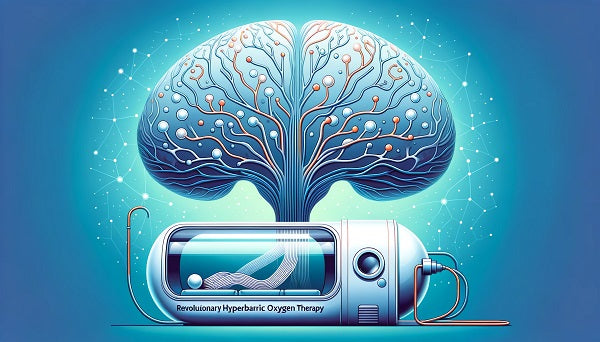
Brain injuries can have devastating effects on neurological health, but Hyperbaric Oxygen Therapy (HBOT) is offering hope for recovery. HBOT involves administering high levels of oxygen in a pressurised chamber, providing numerous benefits for brain injury recovery.
Research supports the use of HBOT, showing improved outcomes and reduced disability. HBOT is emerging as an effective supportive therapy for brain injury recovery. However, more research is needed, and HBOT should be used in conjunction with other treatments under the guidance of a registered healthcare professional.
Key Takeaways
- Hyperbaric Oxygen Therapy restores neurological health following falls and accidents [1] [2] [3].
- Hyperbaric Oxygen Therapy provides increased oxygen supply to the brain [4].
- Hyperbaric Oxygen Therapy reduces disability and improves outcomes.
- Hyperbaric Oxygen Therapy is an effective supportive treatment for brain injury [5].
The Science Behind Hyperbaric Oxygen Therapy for Brain Injury Recovery
The scientific understanding of hyperbaric oxygen therapy (HBO) for brain injury recovery has significantly advanced in recent years. This therapy involves the administration of 100% oxygen at higher than atmospheric pressure, which increases the oxygen supply to the brain.
The mechanisms of action behind HBO therapy for brain injury recovery are multifaceted. It enhances neuroprotective mechanisms, reduces inflammation, lowers intracranial pressure, and enhances cellular metabolism.
Clinical evidence supports the effectiveness of HBO therapy for brain injury recovery. A Cochrane Library review in 2012 showed better Glasgow Outcomes Scale (GOS) and Glasgow Coma Scale (GCS) scores in patients receiving HBO therapy. A systemic review in 2016 confirmed these improvements.
However, more research is needed, especially in the area of rehabilitation. HBO therapy should be used as an adjuvant treatment and initiated in a timely manner for better outcomes in brain injury recovery.
Hyperbaric Oxygen Therapy: Restoring Neurological Health
Numerous studies and clinical evidence have shown that hyperbaric oxygen therapy (HBOT) effectively restores neurological health in patients recovering from brain injuries.
Hyperbaric oxygen therapy research has demonstrated that the treatment provides increased oxygen supply to the brain, enhances neuroprotective mechanisms, and mitigates the damaging effects of brain trauma. It has also been found to lower intracranial pressure, enhance cellular metabolism, and reduce inflammation.
The effectiveness of HBOT in restoring neurological health is supported by research, including a Cochrane Library review in 2012 and a systemic review in 2016, which showed improvements in Glasgow Outcomes Scale (GOS) and Glasgow Coma Scale (GCS) scores.
However, more research is needed on the use of HBOT in rehabilitation settings. Overall, hyperbaric oxygen therapy has proven to be an effective supportive treatment for brain injury, but it should be used in conjunction with other therapies and under the guidance of healthcare professionals.
Exploring the Benefits of Hyperbaric Oxygen Therapy for Brain Injury
Extensive research and clinical studies consistently demonstrate the significant and promising benefits of hyperbaric oxygen therapy (HBOT) for brain injury recovery.
One of the notable benefits is the improvement in cognitive function. HBOT has shown to enhance neuroprotective mechanisms and mitigate the damaging effects of brain trauma.
It provides increased oxygen supply to the brain, boosting oxygen perfusion to deprived areas and enhancing cellular metabolism.
This therapy has also been explored in sports-related brain injuries, where it has shown promising results in reducing inflammation and lowering intracranial pressure.
However, it is important to note that HBOT should be used as an adjuvant treatment and not as a first-line therapy. Further research is needed to better understand the long-term benefits of HBOT for brain injury and its role in rehabilitation.
Hyperbaric Oxygen Therapy as an Adjuvant Treatment for Brain Injury
In recent years, there has been growing interest in the use of hyperbaric oxygen therapy (HBOT) as an adjuvant treatment for brain injury. Research has shown that HBOT can be effective in boosting oxygen perfusion to deprived brain areas, lowering intracranial pressure, enhancing cellular metabolism, reducing programmed death of brain cells (anti-apoptotic), and reducing inflammation.
Several studies have demonstrated the effectiveness of HBOT in improving Glasgow Outcomes Scale (GOS) and Glasgow Coma Scale (GCS) scores in patients with acute traumatic brain injury. However, more research is needed to understand the long-term management and potential benefits of HBOT for brain injury.
It is important to note that HBOT should be used as a supportive treatment alongside other therapies, and consultation with a registered healthcare professional is advised before initiating any treatment. Safety considerations should also be taken into account when considering HBOT as a treatment option.
The Potential Long-Term Benefits of Hyperbaric Oxygen Therapy for Brain Injury
Several studies have indicated the potential long-term benefits of hyperbaric oxygen therapy for brain injury. This innovative therapy has shown promise in reducing neurological deficits and long-term disability caused by brain injury.
While more research is needed to fully understand the long-term management of brain injury with hyperbaric oxygen therapy, it is clear that this treatment can be an effective supportive option. Initiating hyperbaric oxygen therapy along with other treatments has been associated with better clinical outcomes and improved rehabilitation outcomes.
By increasing oxygen supply to the brain, enhancing neuroprotective mechanisms, and reducing inflammation, hyperbaric oxygen therapy may contribute to long-term improvements in brain injury recovery.
However, it is important to note that hyperbaric oxygen therapy should be used in conjunction with other treatments and under the guidance of a registered healthcare professional.
Conclusion
In conclusion, Hyperbaric Oxygen Therapy (HBOT) has shown promise as a groundbreaking treatment for brain injury recovery.
By increasing oxygen supply to the brain, enhancing neuroprotective mechanisms, and reducing inflammation, HBOT has the potential to improve outcomes and reduce neurological deficits.
While more research is needed, HBOT is emerging as an effective supportive therapy when used in conjunction with other treatments and under the guidance of a healthcare professional.
Its potential long-term benefits make it a promising option for brain injury recovery.
For more information on hyperbaric Oxygen chambers, please see our dedicated resource page.
